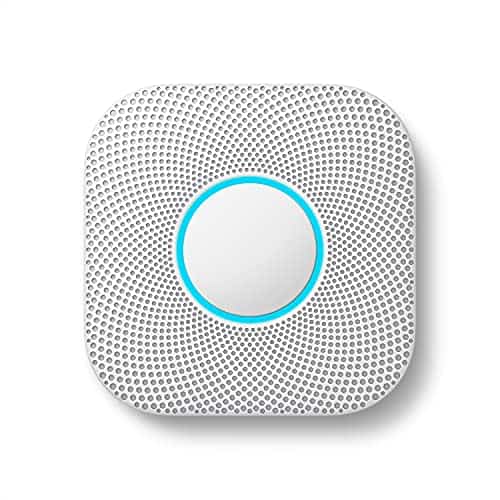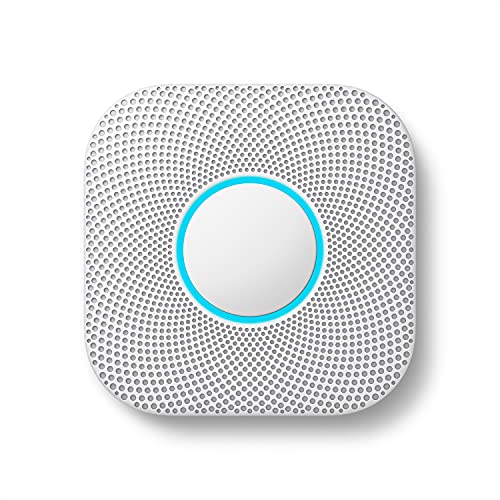The step-by-step guide “How to troubleshoot common issues with a smart smoke detector” is designed to assist users in identifying and resolving common issues that may arise with their smart smoke detectors. The purpose of this guide is to provide a clear and concise set of instructions to help users troubleshoot and rectify any problems they may encounter with their smart smoke detectors. By following the step-by-step instructions, users can gain a better understanding of how to resolve common issues with their smart smoke detectors, ensuring the proper functioning of this essential safety device.
Top-rated smart smoke detectors available now
How to Resolve a Smoke Alarm Chirping Issue with 3 Simple Solutions
Step 1: Power Cycle the Smoke Detector
To power cycle the smoke detector, start by unplugging it from its power source and removing the batteries. Wait for a few minutes to ensure the detector is completely powered down. Next, plug the detector back in and reinsert the batteries. This will reset the smoke detector and may resolve any issues it was experiencing.
Step 2: Check for Proper Installation
To ensure proper installation, carefully follow the manufacturer’s instructions to mount the smoke detector on either the ceiling or the wall. Make sure it is securely fastened in place. Double-check that the detector is correctly positioned according to the provided guidelines.
Step 3: Test the Smoke Detector
To test the smoke detector, press and hold the test button located on the device. While doing so, listen carefully for the alarm sound. In case the alarm does not go off, proceed to replace the batteries and repeat the test. This will ensure that the smoke detector is functioning properly and ready to detect any potential fire hazards.
Step 4: Clean the Smoke Detector
To clean the smoke detector, follow these steps:
- Use a soft brush or vacuum cleaner to gently remove any dust or debris that may have accumulated on the sensors of the smoke detector.
- Make sure to clean the vents of the smoke detector, ensuring they are free from any obstructions or blockages.
- Take care to clean both the front and back of the smoke detector thoroughly, ensuring all surfaces are clear of dust and debris.
- After cleaning, test the smoke detector to ensure it is functioning properly.
Step 5: Check for Interference
Move any electronic devices, appliances, or sources of electromagnetic interference away from the smoke detector. Placing such items too close to the detector can potentially disrupt its functioning. By creating a clear, interference-free environment around the smoke detector, you ensure optimal performance and accurate detection of potential smoke or fire incidents.
Step 6: Update the Firmware
Check the manufacturer’s website for any available firmware updates for your smart smoke detector. To do this, go to the manufacturer’s website and navigate to the support or download section. Look for the model of your smoke detector and see if there are any firmware updates listed. For example, if you have a Nest Protect smoke detector, you can visit the Nest website and go to the support section to check for firmware updates. If there is an update available, follow the instructions provided by the manufacturer to update the firmware. This may involve downloading a file, connecting your smoke detector to your computer, and running a software update.
Step 7: Reset to Factory Settings
If all else fails, refer to the user manual for instructions on resetting the smart smoke detector to its factory settings. Locate the section that provides information on resetting the device and follow the step-by-step instructions precisely. Ensure that you understand the process before proceeding, as resetting to factory settings will erase all personalized settings and revert the device to its original state.
Step 8: Contact Customer Support
If the issue persists or you are unable to troubleshoot the problem on your own, follow the steps below to contact the customer support of the smoke detector manufacturer for further assistance:
- Gather all relevant information about the issue you are facing, including any error messages or specific details about the problem.
- Visit the manufacturer’s website and navigate to the support or contact page.
- Locate the customer support phone number or email address provided on the website.
- Reach out to the customer support team and provide them with a clear description of the problem and any relevant information you have collected.
- Follow any instructions provided by the customer support representative to further troubleshoot the issue or to arrange for repairs or replacements if necessary.
Remember to remain polite and patient while dealing with customer support representatives, as they are there to assist you in resolving the issue with your smoke detector.
Final Thoughts
In conclusion, I have outlined a comprehensive set of troubleshooting steps for common issues encountered with smart smoke detectors. By following the recommended actions of power cycling, ensuring proper installation, conducting routine testing and cleaning, checking for interference, updating firmware, and resetting to factory settings, users can effectively resolve most problems. However, if further assistance is required, reaching out to customer support is always a viable option. By following these troubleshooting techniques, users can ensure the optimal performance and functionality of their smart smoke detectors, providing them with peace of mind and a safer living environment.
Troubleshooting Tips
Instructions for Setting up and Utilizing the Smart Smoke Detector
- Remove the smoke detector from its packaging
- Install the smoke detector on the ceiling or high on the wall, following the manufacturer’s instructions
- Connect the smoke detector to your home’s Wi-Fi network by following the provided instructions
- Download the dedicated mobile app for the smart smoke detector on your smartphone
- Open the app and create an account if required
- Follow the app’s instructions to pair the smoke detector with your smartphone
- Customize the settings of the smoke detector through the app, such as adjusting sensitivity, setting up notifications, and configuring emergency contacts
- Test the smoke detector regularly to ensure it is functioning correctly
- Familiarize yourself with the different alerts and notifications provided by the smart smoke detector
- In case of an emergency, follow the predetermined protocol set in the app or contact emergency services immediately
Frequently Asked Questions about Smart Smoke Detectors
Can a smart smoke detector differentiate between different types of smoke or fire hazards?
Yes, a smart smoke detector can differentiate between different types of smoke or fire hazards. Unlike traditional smoke detectors that only detect the presence of smoke, smart smoke detectors use advanced technologies such as photoelectric and ionization sensors, as well as additional features like heat and carbon monoxide detection, to accurately identify different types of smoke or fire hazards. This allows them to distinguish between slow smoldering fires and fast-flaming fires, as well as other potential dangers such as steam or cooking fumes. Additionally, some smart smoke detectors are equipped with artificial intelligence algorithms that can further enhance their ability to detect and differentiate between various types of smoke or fire hazards.
Is there a specific app or platform that is required to use a smart smoke detector?
Yes, there is usually a specific app or platform that is required to use a smart smoke detector. Most smart smoke detectors come with their own companion app that needs to be installed on a smartphone or tablet. This app is used to connect and sync the smart smoke detector with the user’s device, allowing them to receive alerts, monitor the detector’s status, and control its settings remotely. Additionally, some smart smoke detectors may also require integration with a smart home platform, such as Google Home or Amazon Alexa, to enable voice commands and enhance automation features. It is important to consult the product’s documentation or contact the manufacturer to determine the specific app or platform requirements for a particular smart smoke detector.
Does a smart smoke detector require professional installation or can it be easily installed by the user?
A smart smoke detector can be easily installed by the user without requiring professional installation. Most smart smoke detectors are designed to be user-friendly and come with clear instructions for installation. Typically, they can be mounted on the wall or ceiling using screws or adhesive pads, and connected to a smartphone app or a home automation system for setup and monitoring. However, it is always recommended to carefully read and follow the manufacturer’s instructions to ensure proper installation and functionality.
What is a smart smoke detector and how does it differ from a traditional smoke detector?
A smart smoke detector is an advanced version of a traditional smoke detector that incorporates additional features and capabilities. It utilizes intelligent technology to enhance the safety and convenience of detecting smoke and fire hazards in a home or building.
The main difference between a smart smoke detector and a traditional one lies in its connectivity and functionality. While a traditional smoke detector operates autonomously, a smart smoke detector is designed to connect to a home’s Wi-Fi network and can be controlled and monitored remotely through a smartphone or other smart devices.
Smart smoke detectors offer several distinct advantages over traditional ones. Firstly, they provide real-time alerts and notifications directly to your smartphone or other connected devices, allowing you to respond quickly in case of an emergency, even if you’re not at home. This feature is particularly useful for homeowners who travel frequently or have multiple properties.
Secondly, smart smoke detectors often incorporate additional sensors and technologies, such as carbon monoxide detection or air quality monitoring, providing a more comprehensive safety solution. Some models even integrate with home automation systems, allowing them to trigger other devices like smart lights or door locks in the event of a fire.
Furthermore, smart smoke detectors typically come with advanced features like self-testing and self-monitoring capabilities. They can perform regular diagnostic checks to ensure proper functioning and will alert you if the device requires maintenance or if the battery is low.
In summary, a smart smoke detector is a technologically advanced device that goes beyond the basic functionality of a traditional smoke detector. Its connectivity, remote monitoring capabilities, additional sensors, and integration with other smart home devices make it a more sophisticated and convenient solution for ensuring the safety of your home or building.







I followed all the steps, but my smoke detector still gives false alarms. Any advice on how to troubleshoot this issue?
False alarms can be frustrating. One possible cause could be dust or debris interfering with the smoke detector’s sensors. Make sure to clean the detector thoroughly using the steps mentioned in the guide. Additionally, check for any sources of interference nearby, such as steam or cooking fumes, as they can trigger false alarms. If the problem persists, it’s best to contact the customer support of your specific smoke detector brand for further assistance.
This guide is helpful, but do you have any advanced tips for troubleshooting smart smoke detectors?
Could you cover the topic of connectivity issues and how to address them in a future article? I often face problems with my smart smoke detector losing connection.
I’m sorry to hear that power cycling didn’t resolve the issue. Have you tried checking for proper installation and testing the smoke detector? These steps might help identify the problem. If you continue to experience difficulties, please feel free to share more details so we can provide further troubleshooting advice.
I’ve power cycled my smoke detector multiple times, but it still doesn’t seem to be working. Any other suggestions?
I adapted Step 3 by involving my family members in the testing process. It helped create awareness and educate them about fire safety. Thank you for the guide!
I find it useful to have multiple smart smoke detectors interconnected. It provides an added layer of security, especially in larger homes or multi-story buildings. Consider mentioning this as an optional step in the guide.